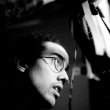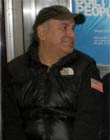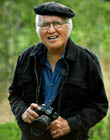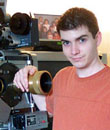|
|
 
|
|
Author
|
Topic: What is the red eye?
|
|
|
Paul Cassidy
Jedi Master Film Handler

Posts: 549
From: Auckland, New Zealand
Registered: Aug 2001
|
 posted 12-27-2002 09:53 AM
posted 12-27-2002 09:53 AM





Usually the Overnight or no sleep Travel , Travel thru the night arrive with Bleary Red eyes , usually not on First Class travel though. ![[sleep]](graemlins/sleep.gif)
Edit of Post to add some cures for the Red Eye . Surviving the Red-Eye
A red-eye flight can be one of the most grueling travel experiences, even on shorter flights. Sleeping on a plane, especially in coach, is a little like staying awake during an Italian film festival, or standing still during a James Brown song. These tips for surviving a red-eye flight should help you weather a night aloft, and help you cope much better upon arrival at your destination.
It's The Sleep, Stupid
The secret to surviving a red-eye is simple: sleep. Despite all your machinations to prepare, adjust, recover, and merely endure before and after your flight, surviving the red-eye is mostly about catching maximum winks en route. Some folks can sleep anywhere, others are kept awake by a pea under 24 mattresses. It helps if you're not a princess when it comes to sleep, or if you arrive at the airport a little tired to start. Wake up early, exercise, and avoid naps on the day of your flight.
Request a Window Seat
A window seat is more conducive to sleep, since you can lean over against the interior wall of the plane without annoying fellow passengers. The head support helps avoid a strained neck upon waking up, and you have more control over the window shade so you can ration sunlight to your own ends.
Also, no one will have to wake you up to climb over you to get out of their seat. Note, however, that most window seats have slightly less legroom than other seats to accommodate the curve of the plane fuselage. In most cases, the tradeoff is worth it.
Request a Seat Near the Front of the Plane
Seats toward the front of the plane are quieter, and less sensitive to turbulence, than seats toward the rear of the plane.
Make Sure Your Seat Reclines
Some seats, especially near the emergency exit rows, do not recline. When you book your seats, or at check-in, ask the agent to make sure your seat reclines.
When Traveling with a Companion
If you're traveling with your spouse, child, other family member, or close friend, put the smaller of the two in the "middle" seat, the larger against the window. That way, if the smaller person wants to lean on the larger person, everyone's more comfortable.
Stake Out a Pillow and Blanket
Airline service absurdity # 134: There are never enough pillows and blankets to go around. Why airlines believe that a pillow per row is acceptable on a red-eye, I can't explain. It's bad enough that some seats don't recline, or that a middle-seat makes it all but impossible to sleep; to be forced to go without a pillow or blanket verges on abuse.
Look for a pillow and blanket in the overhead bins as you board the plane; if you can't find any, ask an attendant to get them for you.
BYO
Bring your own pillow (a good inflatable neck pillow is even more comfortable than they look). Also, bring a sweater as a stand-in for either a pillow or blanket in a pinch.
Fasten Your Seat Belt
A loosely fastened seat belt will prevent flight attendants from waking you up if the plane hits some turbulence. If you are wearing a blanket, consider buckling the seatbelt over your blanket so the attendants can see clearly that you are buckled in.
Lower the Window Shade
On an eastbound red-eye, you are traveling into the rising sun. At an elevation of 30,000 feet, light will be pouring in that window before you know it. Lower the shade, and leave it down.
A practical form of light therapy to beat jet lag is gaining proponents among researchers. The simple explanation is to expose yourself to light according to the time zone at your destination. So, on the classic west-east red-eye, you don't want any light until you arrive. On an east-west red-eye, you want light early in the trip, then as little as possible.
Fall Asleep Immediately After Takeoff
Don't wait for the meal, watch the movie, listen to the music programming, or even attempt to read (although some reading material can help you fall asleep if you're willing to put it down as soon as your eyes droop).
Also, cabin oxygen levels are low from the time you leave the gate until takeoff. This may make you feel sleepy; don't fight it.
Food and Drink
Eat on the schedule of your destination
This usually means a late meal on west-east trips, and no food until you arrive on east-west trips. Skip snacks or meals served at any other times, and sleep instead.
Eat lightly before the flight
This is a personal preference, but many fliers will find that a light meal, with no booze, will let your body reset itself more willingly come touchdown, and makes it easier to sleep on the plane. Your mileage may vary.
Additionally, as a rule, carbohydrates make you sleepy, proteins and fats keep you awake. Bananas and milk are especially effective sleep-inducers.
Alcohol and caffeine
If you're trying to sleep, neither alcohol nor caffeine help the cause. Avoid both.
Water
Water helps the flier's cause in all cases. However, if you're trying to sleep, chugging a quart of water just before takeoff is going to require a mid-flight trip to the toilet. Moderation is the answer here; drink enough water to stay hydrated, but not so much that you're traipsing up and down the aisle of the plane all night.
Layovers Skip the Movie Skip the Movie
Eating is not advised, (see above) but you should drink plenty of water to stay hydrated. My approach is usually to brush my teeth, then head toward the gate, sit near a speaker or the agent, wrap my luggage handle around my wrist or ankle, and put my head back and try to sleep some more. You might ask a gate agent to make sure you don't sleep through the flight departure.
Skip the Movie
Most movies won't put you to sleep, but rather keep you awake. Pass on the headphones, and close your eyes.
Sleep Aids
An eye mask, inflatable neck pillow, ear plugs, and other devices can help the cause greatly. Don't worry about looking funny; bloodshot eyes at your morning meeting look much worse.
If you can fall asleep without the use of pharmaceutical sleep aids, you'll be much better off upon your arrival, as drugs can cause lingering drowsiness or sluggishness that make it hard for your body to reset its internal clock. Gentle aids, such as the motion sickness treatment Dramamine, can dramatically assist you in falling asleep, however, if you have serious difficulties sleeping on planes.
When You Arrive
Raise the window shade when the plane lands
On an east-west flight, that first burst of light will have you blinking hard and miserably, but it will help mightily to reset your internal clock. The last few minutes of shuteye aren't worth stumbling off the plane into an unfamiliar airport before you wake up.
Take stock of your carry-on items
A groggy, half-asleep traveler is much more likely to leave belongings on the plane. Check the back of the seat in front of you as the plane taxis to the gate. Check especially for important items such as your wallet or purse, connecting or return air tickets, identification, keys, and other similar essentials.
Reset your watch
You need to start living by your new time zone. Reset your watch before you get off the plane. In fact, I prefer to reset my watch immediately after I board the last leg of my itinerary, as arrival times are always published in the destination time zone, and I know how long to my destination if I wake up and check the time. This can permit me to grab a few extra precious minutes of sleep.
Begin your day with familiar routines
Rather than indulging your body's clock, live by your watch.
If it's 7AM after an eastbound flight, have breakfast, coffee, whatever you usually do at 7AM. Grab a newspaper if you typically read one every morning. You probably won't feel hungry yet, and the coffee might not go down as smoothly, but soon enough you'll be glad you're on schedule.
If it's 2AM after a westbound flight, head straight for your hotel or home and go to sleep.
| IP: Logged
|
|
|
|
|
|
|
|
|
|
|
|
|
|
|
|
|
|
|
|
All times are Central (GMT -6:00)
|
|
Powered by Infopop Corporation
UBB.classicTM
6.3.1.2
The Film-Tech Forums are designed for various members related to the cinema industry to express their opinions, viewpoints and testimonials on various products, services and events based upon speculation, personal knowledge and factual information through use, therefore all views represented here allow no liability upon the publishers of this web site and the owners of said views assume no liability for any ill will resulting from these postings. The posts made here are for educational as well as entertainment purposes and as such anyone viewing this portion of the website must accept these views as statements of the author of that opinion
and agrees to release the authors from any and all liability.
|

 Home
Home
 Products
Products
 Store
Store
 Forum
Forum
 Warehouse
Warehouse
 Contact Us
Contact Us




 Printer-friendly view of this topic
Printer-friendly view of this topic







![[sleep]](graemlins/sleep.gif)



![[Frown]](frown.gif) I made such a trip a few times in first class and with the food and drinks had made the experience even more interesting. I once had to go to the bathroom on one of those trips when the plane was making it's final approach and that was not fun.
I made such a trip a few times in first class and with the food and drinks had made the experience even more interesting. I once had to go to the bathroom on one of those trips when the plane was making it's final approach and that was not fun.

![[Razz]](tongue.gif)



